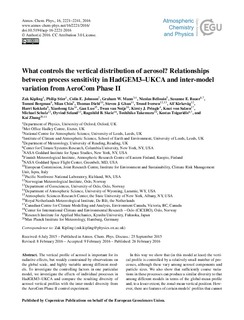What controls the vertical distribution of aerosol? Relationships between process sensitivity in HadGEM3-UKCA and inter-model variation from AeroCom Phase II
Kipling, Zak; Stier, Philip; Johnson, Colin E.; Mann, Graham W.; Bellouin, Nicolas; Bauer, Susanne E.; Bergman, Tommi; Chin, Mian; Diehl, Thomas; Ghan, Steven John; Iversen, Trond; Kirkevåg, Alf; Kokkola, Harri; Liu, Xiaohong; Luo, Gan; van Noije, Twan P.C.; Pringle, Kirsty J.; von Salzen, Knut; Schulz, Michael; Seland, Øyvind; Skeie, Ragnhild Bieltvedt; Takemura, Toshihiko; Tsigaridis, Kostas; Zhang, Kai
Peer reviewed, Journal article
Submitted version
Permanent lenke
http://hdl.handle.net/11250/2466107Utgivelsesdato
2016Metadata
Vis full innførselSamlinger
- Journal articles [478]
Originalversjon
Atmospheric Chemistry and Physics. 2016, 16 (4), 2221-2241. 10.5194/acp-16-2221-2016Sammendrag
he vertical profile of aerosol is important for its radiative effects, but weakly constrained by observations on the global scale, and highly variable among different models. To investigate the controlling factors in one particular model, we investigate the effects of individual processes in HadGEM3–UKCA and compare the resulting diversity of aerosol vertical profiles with the inter-model diversity from the AeroCom Phase II control experiment. In this way we show that (in this model at least) the vertical profile is controlled by a relatively small number of processes, although these vary among aerosol components and particle sizes. We also show that sufficiently coarse variations in these processes can produce a similar diversity to that among different models in terms of the global-mean profile and, to a lesser extent, the zonal-mean vertical position. However, there are features of certain models' profiles that cannot be reproduced, suggesting the influence of further structural differences between models. In HadGEM3–UKCA, convective transport is found to be very important in controlling the vertical profile of all aerosol components by mass. In-cloud scavenging is very important for all except mineral dust. Growth by condensation is important for sulfate and carbonaceous aerosol (along with aqueous oxidation for the former and ageing by soluble material for the latter). The vertical extent of biomass-burning emissions into the free troposphere is also important for the profile of carbonaceous aerosol. Boundary-layer mixing plays a dominant role for sea salt and mineral dust, which are emitted only from the surface. Dry deposition and below-cloud scavenging are important for the profile of mineral dust only. In this model, the microphysical processes of nucleation, condensation and coagulation dominate the vertical profile of the smallest particles by number (e.g. total CN > 3 nm), while the profiles of larger particles (e.g. CN > 100 nm) are controlled by the same processes as the component mass profiles, plus the size distribution of primary emissions. We also show that the processes that affect the AOD-normalised radiative forcing in the model are predominantly those that affect the vertical mass distribution, in particular convective transport, in-cloud scavenging, aqueous oxidation, ageing and the vertical extent of biomass-burning emissions.
